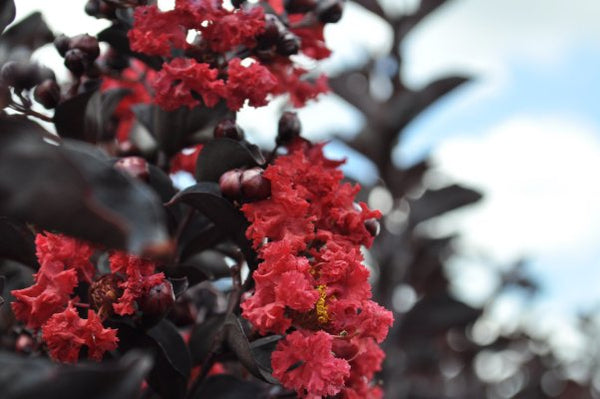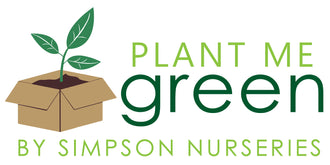Choosing the Right Crape Myrtle for You
Summer time is ushered in by a myriad of things – a long awaited school break, the taste of just-cut watermelon on the front porch, the sound of waves rolling onto the shore, and – for me – the colorful parade of crape myrtles blooming. Nothing looks quite like summer in the South than the bloom explosion of crape myrtles. These trees and shrubs line fences, frame buildings, dot yards, and everywhere they are they bring large bursts of red, pink, purple, and white flowers. Not only do crape myrtles usher in summer for me, but they always seem to do so with humble grace, and I think that's what I like so much about them.
Perhaps you love crape myrtles as much as I do, and perhaps like me, you spend a lot of time admiring these trees in other people's yards and occasionally you think, "Hum, wouldn't it be nice to have my OWN crape myrtle. You know, one that's in MY yard and that I can admire all that I want, whenever I want."
Ok, so let's say you've made the jump and you're on board to plant your very own crape myrtle.
Except now that you think of it, there are quite a lot of crape myrtle varieties each with their own unique qualities. That deep red-flowered one looks so nice in your neighbor's yard and so do those ones with the white bark that line the streets downtown. And then there are those crape myrtles down the road that seem to be blooming all summer long. So many choices! Exactly how do you decide which crape myrtle is right for you?
I like charts so that I can see a lot of information all at once, and Plant Me Green has conveniently made a crape myrtle guide that outlines the characteristics of our varieties and should help you find your perfect match. But what exactly should you look for in our guide?
Like any other plant purchasing decision, the first thing to do in choosing a crape myrtle is to consider your USDA Zone. If you are not sure which zone you are in (or – like me – you need a reminder because you have a million numbers floating around in your head) you can take a look at a USDA Zone map or use a ZIP code look-up (both of which can be found on our website). Always be aware what zone you are in and the recommended hardiness zone of the crape myrtle you are considering. Our crape myrtles are hardy in zones 7-9 with some flourishing in zones 6 and/or 10 as well. But what if you live outside of a crape myrtle's hardiness zone? Is it inevitable defeat? Not necessarily. Consider container planting a smaller, bush-like crape myrtle such as one of the Magics or one of the Black Diamonds. The Black Diamonds, for instance, can be container grown in zones 2-5 if taken inside during the winter months. Knowing your USDA Zone is the first step in deciphering which crape myrtles are possible choices for you. And aren't difficult choices so much easier when we can narrow them down?
Besides your USDA Zone, the second most-important consideration for your crape myrtle is mature height. Some crape myrtles mature to less than 10 feet and tend to grow like a shrub while other tree-like crape myrtles can reach as high as 30 feet tall. You'll want to consider both in deciding what you want in your yard and the space you have available. I'd love a huge crape myrtle tree in my yard. Unfortunately, my yard is rather small and there are already a lot of trees with large canopies which a tall crape myrtle might eventually run into. As much as you might want to be impulsive and live for the moment, successful planting always requires thinking ahead. Your crape myrtle may be small now, but it will grow; make sure your crape myrtle has plenty of room to reach its mature height.
After considering zones and mature height, most of the other crape myrtle characteristics are a matter of opinion, and can be considered in the order of your personal importance. For instance, if flower color is most important for you, narrow your selections down based on that criterion (our crape myrtle guide has a handy flower color chart that may help here). If flower color doesn't matter that much to you, what does? Bark, flowering days, leaf color, growth habit? Every crape myrtle has unique characteristics, and there's one that is just right for you!

Now before you get carried away, remember that a crape myrtle may look good on paper but that doesn't guarantee that it will look good in your yard. So before you make a decision, make sure to take a good, long look at your current yard. Besides looking at the space in your yard, you may want to consider the colors of your landscaping and keep them in mind as you choose flower and leaf color. What other plants are blooming in your summer yard and what crape myrtle flower color would compliment them? If you are planting your crape myrtle near your house, also consider your house color. A white flower, for instance, might stand out more against a brick house than a red flower. A red one, however, might look nice against, say, green shutters.
Choosing the right crape myrtle might take some time – impulse shoppers beware! As much as I love all crape myrtles, they certainly will not all work in my yard. So find a nice meeting ground between what you want and what works in your space. And when you're done, despite the time and effort – the sight of your very own crape myrtle exploding into summer bloom will definitely be worth it. Your future says, thank you.
Here are a few more tips to help you choose the right crape myrtle for you (and keep it right):
- If you are looking for a more disease and mildew resistant crape myrtle, consider the Magics or the Black Diamonds
- If bark is important to you, the Lipan, Miami, and Natchez have the best exfoliating bark
- Smaller, bush-like crape myrtles such as the Magics or Black Diamonds work nicely for a hedge
- If you want a taller crape myrtle, consider the Arapaho, Biloxi, Muskogee, Natchez, Tuscarora, or Miami
- If you want your crape myrtle to grow tree-like, train it to do so by pruning in the winter
- All crape myrtles love sun and need it for flower production, so make sure to pick a sunny spot in your yard to plant



Comments
AL SAVILL said:
Afew weeks ago I had the fabulous pleasure OF visiting the PMG nursery outside Monticello, Fla. Richard and Stephanie immediately made me feel welcome and the tour of there property was beautiful. Like nothing I had ever seen before. Everything is clean and neat, with plants in all sizes and colors within each variety . I highly recommend a visit when you are in the area. But call ahead because they are a very busy wholesale grower. Thanks again PMG staff it was truly a highlight in my love for plants.